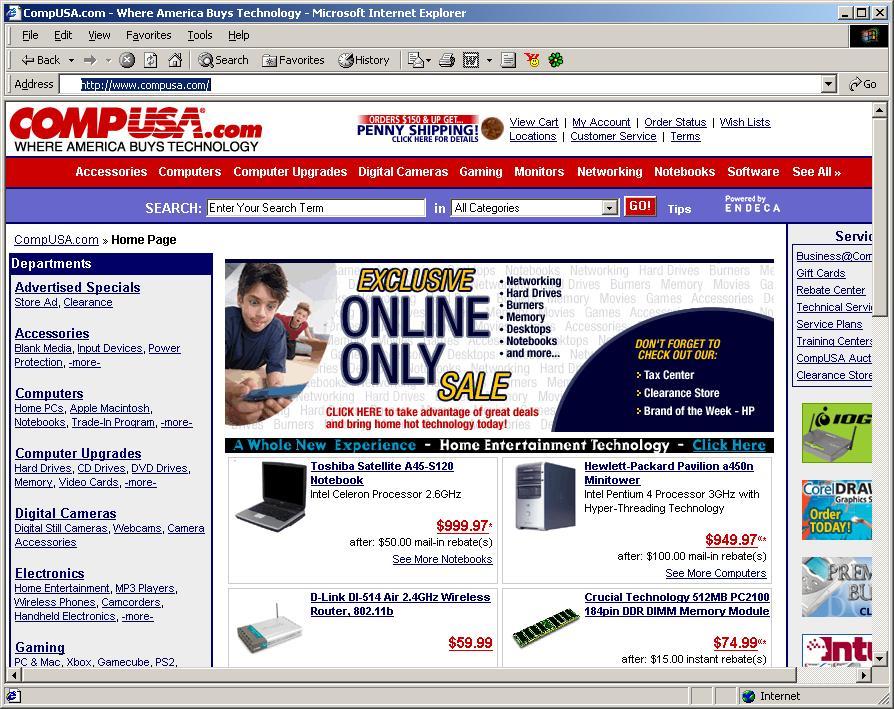
- •А.Д. Музафарова а.Г. Ковалева
- •Vocabulary practice section 1
- •Vocabulary practice section 2
- •Vocabulary practice section 3
- •This week: software
- •Vocabulary practice section 1
- •Vocabulary practice section 2
- •Internet: Voice recognition takes off
- •Programming languages.
- •Vocabulary practice section 1
- •Vocabulary practice section 2
- •Int — international organization
- •Vocabulary practice section 3
- •The 15 enemies of the Internet
- •Internet crime
- •Vocabulary practice section 1
- •Vocabulary practice section 2
- •Vocabulary practice section 3
- •How a virus infects a program
- •Vocabulary practice section 1
- •Video Games
- •Vocabulary practice section 2
- •Vocabulary practice setion 3
- •Vocabulary practice setion 4
- •Twitter's transmitters
- •Vocabulary practice section 1
- •Good Web Design? What Is It?
- •Vocabulary practice section 2
- •Vocabulary practice section 3
- •Top Five Ways to Make Your Site More Popular
- •1. Strong Hosting
- •2. Optimize Your Website
- •3. Take Advantage of Social Media Optimization
- •4. Get Your Visitors Involved
- •5. Emphasize Usability in Your Design
- •You’ve been in graphics too long if…
- •Internet
- •Web design
Vocabulary practice section 1
1. Find the information in Key information section 1 and decide if these sentences are true or false. If they are false, correct them.
1. The Internet and the World Wide Web are synonyms.
2. Computers need to use the same protocol (TCP / IP) to communicate with each other.
3 .
Web TV can provide access to the Net.
.
Web TV can provide access to the Net.
4. ADSL and cable are two types of dial-up connections.
5. External, internal and PC card are types of modems.
6. Information can be sent through telephone lines, satellites and power lines.
7. The computer IP number is a way to identify it on the Internet.
8. A newsreader is an application program that reads articles on Usenet.
2. What Internet system should these people use?
1. ‘I like receiving daily updates and headlines from newspapers on my computer.’
2. ‘I’m doing some research and need computer access to the University library.’
3 .
‘I’d like to avoid flying to Japan to attend the meeting but I
want to seewhat's
going
on
there.’
.
‘I’d like to avoid flying to Japan to attend the meeting but I
want to seewhat's
going
on
there.’
4. ‘I want to read people’s opinions about environmental issues and express my views.’
5. ‘I have designed a web page and want to transfer the data to my reserved web space.’
6. ‘I’d like to check my students’ draft essays on my computer and send them back with my suggestions.’
7. ‘I don’t want to spend too much money on international phone calls but I love hearing his voice.’
8. ‘I live in a small village where there are no other teenagers. I wish I had the chance to meet and chat with friends.
3. Decode the abbreviations from Key Information Section 1. Use the ICT dictionary, if necessary.
WWW, TCP, IP, ADSL, PDA, PSTN, VoIP, VoBB, FTP.
4. Choose the correct alternatives to complete this newspaper article.
Sharing your broadband connection with your neighbours is either the best way of making friends or the fastest way to lose them. Thanks to new European legislation, (1) modem / wireless/ telephone technology and a firm called MyZoness several households within 300 metres of each other can now share the cost of fast (2) broadband / dial-up / phone access. But the more people using your (3) network/chat/ Internet telephony, the slower it gets. If four people are using it at once, the surfing (4) volume/speed/size is 128kb. Clive Mayhew-Begg, chief executive of MyZones, says: ‘Sharing broadband is just the start of a new generation of consumer-based Internet services.’ It starts on July 25 when MyZones will start selling £150 starter kits. These include a wi-fi (wireless technology) point and ADSL (3) 3G / modem /Web TV but not the wi-fi adapters you and your neighbours will need. These will cost an extra £60 or so for each computer logged on to the wireless network.
5. Complete the conversation between an Internet Service Provider (ISP) and a customer. Add words from the box into spaces 1–16.
|
email Web spam IP modem wireless newsreader username browser internet attachments messaging file transfer protocol newsgroups broadband mail program |
I SP
Helpdesk Operator (HO):Customer
support, good morning.
SP
Helpdesk Operator (HO):Customer
support, good morning.
Customer (C): Yeah, hi. Who am I speaking to?
HO: My name’s Martin. How can I help?
C: I’m having some problems with my (1) … connection. I can’t get online.
HO: OK. I’m sure I can help. Let me just quickly check your (2) … address .
C: My what? What does that mean?
HO: It’s just a unique series of numbers that identifies your computer when it’s online. OK, just wait a sec … Mmm … Is your (3) … plugged in and working OK?
C: Is that the same as the (4) … router? The thing that plugs into the phone line?
HO: Yes. Are the lights flashing?
C: Yes, they’re flashing really fast.
HO: OK. Just turn the router off and on at the back. Is it working now?
C: Yes, it is. How did that happen?
HO: It’s nothing serious – sometimes you just need to reset the router. Is there anything else I can help you with?
C: Actually, yes. I’m paying all this money for one of those fast, what do you call them, (5) … connections, but all I’m using the computer for is checking (6) … and looking up information on the (7) … . What else can I do with all this technology?
HO: Well, have you tried instant (8) …? You know, having real-time chats with friends over the Internet?
C: How old do you think I am? That sounds like the kind of thing my 15-year-old son would be into, not me!
HO: OK, well. How fast is your connection? If it’s very fast, then you can take advantage of (9) … – that means downloading files from the Internet onto your hard drive. It’s a feature that is built into your web (10) …, so it’s very easy to use. You can download music, films, anything you want, really.
C: That sounds expensive. How much does it cost to download a song?
HO: It depends on the site. Another thing you might want to try is (11) … – public discussion areas on nearly any topic. It’s part of a system called Usenet. You’ll need a (12) … – that’s a program that lets you view and post messages – and a (13) … and password. It’s all very easy.
C: OK, that all sounds interesting. Thanks for all.
HO: Actually, you might be interested in a new product we’ve launched this week. Can I ask which (14) … you use?
C: Outlook Express.
HO: OK, we have some new anti-(15) … software that helps detect junk email by looking for suspicious words in the subject line of the email. It also looks for suspicious (16) … – that’s how viruses are normally sent between computers. It only costs £5.99 a month.
KEY INFORMATION SECTION 2
|
|
|
|
The World Wide Web, Web or WWW is a network of documents that works in a hypertext environment, i.e. using text that contains links, hyperlinks (a reference to a document that the reader can directly follow) to other documents.
The files, web pages, are stored in computers, which act as servers. A webpage or web page is a
d ocument
or resource of information that is suitable for the World
Wide Web
and can be accessed through a web
browser
and displayed on a computer
screen.
This information is usually in HTML
(Hyper Text Markup Language)
or XHTML
(Extensible
Hypertext Markup Language)
format, and may provide navigation
to other webpages via hypertext
links.
Webpages may be retrieved from a local computer or from a remote web
server.
The web server may restrict access only to a private network, e.g. a
corporate intranet,
or it may publish pages on the World Wide Web. Webpages are requested
and served from web servers
using Hypertext
Transfer Protocol
(HTTP). Webpages may consist of files of static text stored within
the web
server's
file system (static
webpages),
or the web server may construct the (X)HTML for each webpage when it
is requested by a browser (dynamic
webpages).
ocument
or resource of information that is suitable for the World
Wide Web
and can be accessed through a web
browser
and displayed on a computer
screen.
This information is usually in HTML
(Hyper Text Markup Language)
or XHTML
(Extensible
Hypertext Markup Language)
format, and may provide navigation
to other webpages via hypertext
links.
Webpages may be retrieved from a local computer or from a remote web
server.
The web server may restrict access only to a private network, e.g. a
corporate intranet,
or it may publish pages on the World Wide Web. Webpages are requested
and served from web servers
using Hypertext
Transfer Protocol
(HTTP). Webpages may consist of files of static text stored within
the web
server's
file system (static
webpages),
or the web server may construct the (X)HTML for each webpage when it
is requested by a browser (dynamic
webpages).
Your computer, the client, uses a web browser, a special program to access and download web pages. The web pages are organized in websites, groups of pages located on the Web, maintained by a webmaster, the manager of a website.
The Web enables you to post and access all sorts of interactive multimedia information and has become a real information highway (route or network for the high-speed transfer of information).
T o
surf or navigate the Web, access and retrieve web pages or websites,
you need a computerwith
an Internet connection and a web browser. After you have launched it,
you must type the website address or URL
(Uniform
Resource Locator),
which may look like this:
o
surf or navigate the Web, access and retrieve web pages or websites,
you need a computerwith
an Internet connection and a web browser. After you have launched it,
you must type the website address or URL
(Uniform
Resource Locator),
which may look like this:
|
http:// |
www. |
cup.org/ |
education |
sample.htm |
|
http:// |
indicates the type of protocol that the server and browser will use to communicate. Here it is Hypertext Transfer Protocol, www. | |||
|
www. |
shows that it is a resource on the World Wide Web. | |||
|
cup.org/ |
is the domain name of the web server that hosts the website | |||
|
education |
is the path, the place where a web page is located | |||
|
sample.htm |
is the filename or name of a single web page | |||
The different parts are separated by full stops (.) and forward slashes (/). When we say a URL, we say dot (.) and slash (/).
W ithin
a single directory,filenames
must be
unique. Since filename also applies for subdirectories, it is also
not possible to create equally named file and subdirectory entries in
a single directory. However, two files in different directories may
have the same name. In some operating systems, such as MS-DOS,
Microsoft
Windows,
and classic Mac
OS,
upper-case letters and lower-case letters in file names are
considered the same, so that, for example, the file names "MyName"
and "myname" would be considered the same, and a directory
could not contain a file with the name "MyName" and another
file with the name "myname". The file systems in those
operating systems are called "case-insensitive".
In most file systems in Unix-like
systems, however, upper-case and lower-case are considered different,
so that files “MyName”
and “myname”
would be valid names for different files concurrently in the same
directory.
ithin
a single directory,filenames
must be
unique. Since filename also applies for subdirectories, it is also
not possible to create equally named file and subdirectory entries in
a single directory. However, two files in different directories may
have the same name. In some operating systems, such as MS-DOS,
Microsoft
Windows,
and classic Mac
OS,
upper-case letters and lower-case letters in file names are
considered the same, so that, for example, the file names "MyName"
and "myname" would be considered the same, and a directory
could not contain a file with the name "MyName" and another
file with the name "myname". The file systems in those
operating systems are called "case-insensitive".
In most file systems in Unix-like
systems, however, upper-case and lower-case are considered different,
so that files “MyName”
and “myname”
would be valid names for different files concurrently in the same
directory.
To find interesting sites you can use search engines, where the website information is compiled by spiders, computer-robot programs that collect information from sites by using keywords, or through web indexes, subject directories that are selected by people and organized into hierarchical subject categories. Some web portals - websites that offer all types of services, e.g. email, forums, search engines, etc. - are also good starting points.
The most relevant website addresses can be stored in your computer using the bookmarks or favourites function in your browser.
Websites usually have a beginning page or home page. From this starting point you can navigate by clicking your mouse on hyperlinks in texts or images.
The Web is an open door to a universe of multimedia resources that people use in many different ways. Here are just a few.
|
|
In my weblog, an electronic journal I maintain on the Web, you can read and post opinions in chronological order. In my role as blogger, the manager of a blog, I can promote this new type of discussion. |
|
|
E--learning education via the Web, is a great opportunity for people like me who haven’ t got time to attend classes.
|
|
|
Online shopping, i.e. cybershopping or e-commerce, saves you time and gives you a comfort of buying from your personal computer. The goods are then sent to you, so it’s very easy. |






